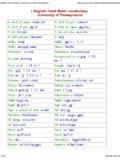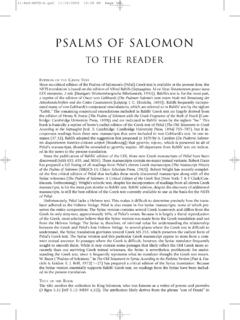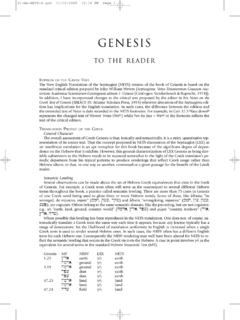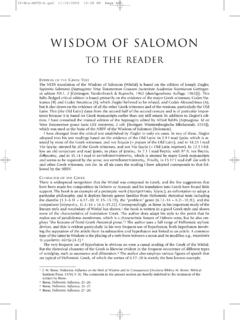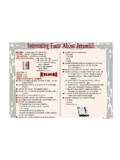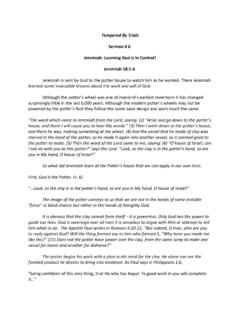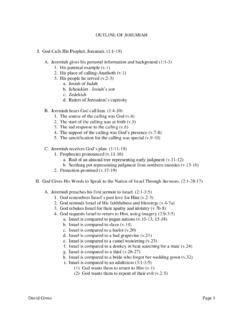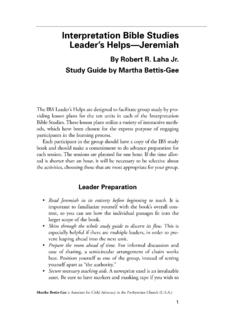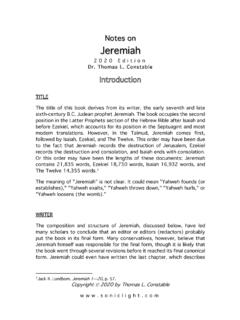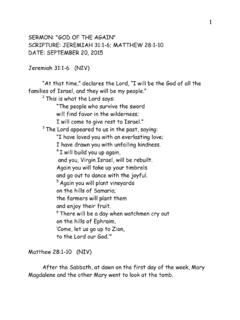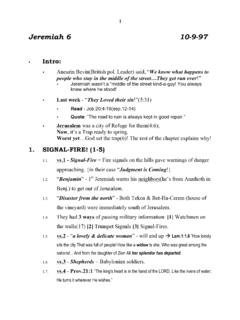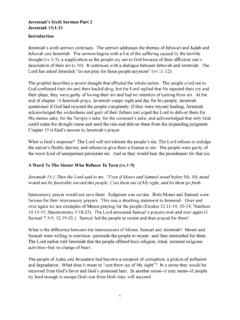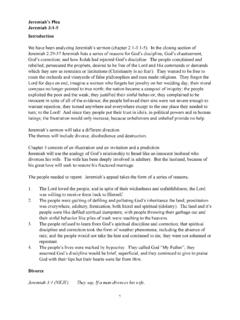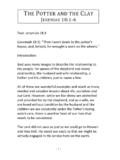Transcription of A New English Translation of the Septuagint. 34. Ieremias
1 11/10/2009 10:40 PM Page 876. Ieremias . TO THE READER. EDITION OF THE GREEK TEXT. The New English Translation of the septuagint (NETS) version of Ieremias is based on the critical edition of Joseph Ziegler (Septuaginta: Vetus Testamentum Graecum Auctoritate Societatis Litterarum Gottingensis ed- itum XV: Ieremias Baruch Threni Epistula Ieremiae [G ttingen: Vandenhoeck & Ruprecht, 1957]), though in a number of instances, notably in chapter 43, we have deviated from Ziegler's edition. The deviation in ( way > threshold ) NETS owes to J.
2 No systematic and thorough text-critical reassess- ment has, however, been carried out. Translation PROFILE OF THE GREEK. General Character Given that, according to opinio communis, Greek jeremiah (hereafter Ieremias ) is based on a Hebrew text substantially at variance with MT, a comparison of the Greek with its source text is no straightforward task. It is nevertheless reasonably clear that the most basic norm of the translator (hereafter Ier2) was that of iso- morphism. That is to say, typically each morpheme of the source text is represented in the target text.
3 This is true not only of so-called content words (lexemes) but as well of structure words. For example, Hebrew articles, notae accusativi, infinitival prefix l, personal pronouns (even when rendered superfluous by Greek inflection), pronominal suffixes, pleonastic pronouns and adverbs, prepositions, and conjunctions are all regularly represented, whether or not such representation results in standard Greek usage. Though certain structural items are at times added in deference to Greek usage, this occurs almost exclusively at the level of phrase and clause and rarely at the level of discourse.
4 Moreover, deference to Greek literary style was often trumped by Ier's isomorphism, as a result of which Greek articles are notably in short supply. Be it noted, however, that isomorphism need not mean lexical or grammatical consistency. Thus He- brew prepositions may at times trigger Greek articles, in the same sort of way that a Hebrew lexeme may be assigned a number of Greek counterparts, differentiated according to contextual demand, whether lin- guistic or expositional, even though the context may be rather narrowly conceived.
5 In spite of its isomorphism, Ieremias is usually intelligible though rarely elegant. Yet the reader en- counters many instances of unintelligibility. As good an example as any is perhaps , the more since it contains transcriptions (see further below): kai\ ta\ saffwq kai\ ta\ masmarwq kai\ tou\j u9poxuth~raj kai\ ta\j luxni/aj kai\ ta\j qui/skaj kai\ tou\j kua/qouj, a4 h]n xrusa~ xrusa~ kai\ a4 h]n a0rgura~ a0rgura~, e1laben o9 a0rxima/geiroj. Though this line is an exact representation of the Hebrew source text which was evi- dently very much like MT what was a Greek reader without access to the Hebrew to make of it?
6 NETS. has glossed it as: And the chief cook took away the saphphoth and the masmaroth and the pitchers and the lampstands and the censers and the ladles, which were gold gold and which were silver silver, with a few notes attached to help the reader of English . Problems encountered by Ier in the source text are typ- ically passed on to the reader. Difficulties, too, may be caused by uncertain referents/antecedents of pronominals ( , ; , 20; ). Especially the Oracles Against the Nations (OAN) present many uncertainties of various kinds.
7 All the same, Ier is not totally oblivious to Greek literary conven- tions. So for example in 26 he renders the fourfold yty)r ( I looked at ) of his source into two pairs of e0pe/bleya .. ei]don. All in all, though, Ieremias often lacks semantic transparency, because too little attention was paid to units of discourse beyond the clausal level. Stipp rightly notes that diese bersetzung auf sprachliche Gl tte wenig R cksicht nahm und in s- thetischer Hinsicht ihren Lesern nicht entgegenkam. 3. 1 Jannes Smith, jeremiah 52: Thackeray and Beyond, BIOSCS 35 (2002) 55 96, esp.
8 83. 2 The label is not intended to preclude more than one translator. 3 Hermann-Josef Stipp, Das masoretische und alexandrinische Sondergut des Jeremiabuches (Freiburg/G ttingen: Universit tsverlag/Vandenhoeck & Ruprecht, 1994) 27 ( This Translation paid little attention to linguistic polish and aesthetically failed to accommodate its readers. ). 11/10/2009 10:40 PM Page 877. to the reader of Ieremias 877. Of Consistency and Inconsistency Though Ier's most basic norm is that of isomorphism, as noted, this does not need to mean a heavy emphasis on lexical/grammatical consistency.
9 As a result, predictable Hebrew-Greek equivalency and iso- morphism may be quite distinct. While lack of consistency can suggest different agents whether trans- lators or revisers it is equally true that one and the same agent may make use of such inconsistency to slip into his text interpretive elements, whether of purely local import or possibly with a larger scope. We are here interested in such marked usage, especially those instances that are not readily explained as obligatory differentiation in the target language.
10 Here we note some interesting examples. Though the textual facts are clear, the reasons for them are not always so. In each case, the item in question is dis- tributed throughout the book. Variation at the Word Level 1a nekro/j ( corpse ) ; ; ; 1b qnhsimai=on ( carcass ) ; ; In all but the Hebrew term is hlbn, used for a dead body of human and animal alike. Though in this case one can scarcely speak of a default Hebrew-Greek equivalency, the difference in rendering nevertheless invites examination.
